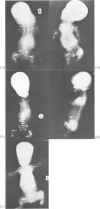Abstract
Four cases of lethal short rib-polydactyly syndrome (SRPS) from three non-consanguineous families are described. Radiological features were similar in all four cases and were most consistent with type III SRPS (Verma-Naumoff syndrome), but many differences in external and systemic abnormalities were noted. The considerable overlap of supposedly distinctive features displayed by the three main forms of SRPS is suggestive of a single locus mutation with variable expressivity, particularly for types I and III, possibly related to different mutant alleles and secondary intrauterine modification of the phenotype. All four cases showed anomalous sexual development. In spite of testicular differentiation in all four and a 46, XY karyotype in the two on whom chromosome studies were done, two infants were phenotypic females and two had ambiguous genitalia. A definitive diagnosis of SRPS was made at 26 weeks' gestation in a pregnancy at risk.
Full text
PDF







Images in this article
Selected References
These references are in PubMed. This may not be the complete list of references from this article.
- Belloni C., Beluffi G. Short rib-polydactyly syndrome, type Verma-Naumoff. Rofo. 1981 Apr;134(4):431–435. doi: 10.1055/s-2008-1056384. [DOI] [PubMed] [Google Scholar]
- Bernstein R. The Y chromosome and primary sexual differentiation. JAMA. 1981 May 15;245(19):1953–1956. [PubMed] [Google Scholar]
- Bidot-López P., Ablow R. C., Ogden J. A., Mahoney M. J. A case of short rib polydactyly. Pediatrics. 1978 Mar;61(3):427–432. doi: 10.1542/peds.61.3.427. [DOI] [PubMed] [Google Scholar]
- Black I. L., Fitzsimmons J., Fitzsimmons E., Thomas A. J. Parental consanguinity and the Majewski syndrome. J Med Genet. 1982 Apr;19(2):141–143. doi: 10.1136/jmg.19.2.141. [DOI] [PMC free article] [PubMed] [Google Scholar]
- Chen H., Yang S. S., Gonzalez E., Fowler M., Al Saadi A. Short rib-polydactyly syndrome, Majewski type. Am J Med Genet. 1980;7(2):215–222. doi: 10.1002/ajmg.1320070214. [DOI] [PubMed] [Google Scholar]
- Cherstvoy E. D., Lurie I. W., Shved I. A., Lazjuk G. I., Ostrowskaya T. I., Usoev S. S. Difficulties in classification of the short rib-polydactyly syndromes. Eur J Pediatr. 1980;133(1):57–61. doi: 10.1007/BF00444756. [DOI] [PubMed] [Google Scholar]
- Cooper C. P., Hall C. M. Lethal short-rib polydactyly syndrome of the Majewski type: a report of three cases. Radiology. 1982 Aug;144(3):513–517. doi: 10.1148/radiology.144.3.7100463. [DOI] [PubMed] [Google Scholar]
- Habeck J. O., Künzel W., Müller D., Tode G., Schmidt J. Kurzrippen-Polydaktylie-Syndrom Typ III (Verma-Naumoff) mit Zeichen einer ektodermalen Dysplasie. Zentralbl Gynakol. 1982;104(9):568–575. [PubMed] [Google Scholar]
- Hall B. D., Spranger J. W. Campomelic dysplasia. Further elucidation of a distinct entity. Am J Dis Child. 1980 Mar;134(3):285–289. doi: 10.1001/archpedi.1980.02130150039010. [DOI] [PubMed] [Google Scholar]
- Kaibara N., Eguchi M., Shibata K., Takagishi K. Short rib-polydactyly syndrome type I, Saldino-Noonan. Eur J Pediatr. 1980;133(1):63–65. doi: 10.1007/BF00444757. [DOI] [PubMed] [Google Scholar]
- Kataria S., Kushnick T. Picture of the month. Short-rib polydactyly dwarfism: Saldino-Noonan type. Am J Dis Child. 1982 Jul;136(7):639–640. [PubMed] [Google Scholar]
- Krepler R., Weissenbacher G., Leodolter S., Müller-Tyl E. Nicht lebensfähiger, mikromeler Zwergwuchs: Thoraxdystrophie-Polydaktylie-Syndrom Typ Saldino-Noonan. Monatsschr Kinderheilkd. 1976 Apr;124(4):167–173. [PubMed] [Google Scholar]
- Lowry R. B., Wignall N. Saldino-Noonan short rib-polydactyly dwarfism syndrome;. Pediatrics. 1975 Jul;56(1):121–123. [PubMed] [Google Scholar]
- Majewski F., Pfeiffer R. A., Lenz W., Müller R., Feil G., Seiler R. Polysyndaktylie, verkürzte Gliedmassen und Genitalfehlbildungen: Kennzeichen eines selbständigen Syndroms. Z Kinderheilkd. 1971;111(2):118–138. [PubMed] [Google Scholar]
- Meyerowitz B. R. Medi-cal: a debacle? West J Med. 1980 Nov;133(5):449–450. [PMC free article] [PubMed] [Google Scholar]
- Motegi T., Kusunoki M., Nishi T., Hamada T., Sato N., Imamura T., Mohri N. Short rib-polydactyly syndrome, Majewski type, in two male siblings. Hum Genet. 1979 Jul 18;49(3):269–275. doi: 10.1007/BF00569346. [DOI] [PubMed] [Google Scholar]
- Naumoff P., Young L. W., Mazer J., Amortegui A. J. Short rib-polydactyly syndrome type 3. Radiology. 1977 Feb;122(2):443–447. doi: 10.1148/122.2.443. [DOI] [PubMed] [Google Scholar]
- Piepkorn M., Karp L. E., Hickok D., Wiegenstein L., Hall J. G. A lethal neonatal dwarfing condition with short ribs, polysyndactyly, cranial synostosis, cleft palate cardiovascular and urogenital anomalies and severe ossification defect. Teratology. 1977 Dec;16(3):345–350. doi: 10.1002/tera.1420160315. [DOI] [PubMed] [Google Scholar]
- Richardson M. M., Beaudet A. L., Wagner M. L., Malini S., Rosenberg H. S., Lucci J. A., Jr Prenatal diagnosis of recurrence of Saldino-Noonan dwarfism. J Pediatr. 1977 Sep;91(3):467–471. doi: 10.1016/s0022-3476(77)81327-9. [DOI] [PubMed] [Google Scholar]
- Rodeck C. H. Fetoscopy guided by real-time ultrasound for pure fetal blood samples, fetal skin samples, and examination of the fetus in utero. Br J Obstet Gynaecol. 1980 Jun;87(6):449–456. doi: 10.1111/j.1471-0528.1980.tb04577.x. [DOI] [PubMed] [Google Scholar]
- Rupprecht E., Gurski A. Kurzrippen-Polydaktylie-Syndrom Typ Saldino-Noonan bei zwei Geschwistern. Helv Paediatr Acta. 1982 May;37(2):161–169. [PubMed] [Google Scholar]
- Saldino R. M., Noonan C. D. Severe thoracic dystrophy with striking micromelia, abnormal osseous development, including the spine, and multiple visceral anomalies. Am J Roentgenol Radium Ther Nucl Med. 1972 Feb;114(2):257–263. doi: 10.2214/ajr.114.2.257. [DOI] [PubMed] [Google Scholar]
- Sillence D. O. Non-Majewski short rib-polydactyly syndrome. Am J Med Genet. 1980;7(2):223–229. doi: 10.1002/ajmg.1320070215. [DOI] [PubMed] [Google Scholar]
- Spranger J., Grimm B., Weller M., Weissenbacher G., Herrmann J., Gilbert E., Krepler R. Short rib-polydactyly (SRP) syndromes, types Majewski and Saldino-Noonan. Z Kinderheilkd. 1974 Jan 17;116(2):73–94. doi: 10.1007/BF00491508. [DOI] [PubMed] [Google Scholar]
- Verma I. C., Bhargava S., Agarwal S. An autosomal recessive form of lethal chondrodystrophy with severe thoracic narrowing, rhizoacromelic type of micromelia, polydacytly and genital anomalies. Birth Defects Orig Artic Ser. 1975;11(6):167–174. [PubMed] [Google Scholar]
- Walley V. M., Coates C. F., Gilbert J. J., Valentine G. H., Davies E. M. Brief clinical report: short rib-polydactyly syndrome, Majewski type. Am J Med Genet. 1983 Mar;14(3):445–452. doi: 10.1002/ajmg.1320140307. [DOI] [PubMed] [Google Scholar]
- Yang S. S., Lin C. S., Al Saadi A., Nangia B. S., Bernstein J. Short rib-polydactyly syndrome, type 3 with chondrocytic inclusions: report of a case and review of the literature. Am J Med Genet. 1980;7(2):205–213. doi: 10.1002/ajmg.1320070213. [DOI] [PubMed] [Google Scholar]






